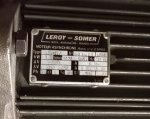PetrosA
Senior Member
- Location
- Lancaster, Pennsylvania
A machinist buddy of mine asked for some help that's challenging me to learn some 
He has a 3-phase milling machine currently working off a phase converter. Speed control is via belts and pulleys on the machine. He would like to look at VFD options if it would allow him to control speed on-the-fly.
It seems to me that this is possible based on some videos I've seen on youtube where it looks like guys have used a VFD to go from single to three phase and use them to control speed as well.
What do I need to get to make this work?
Thanks
He has a 3-phase milling machine currently working off a phase converter. Speed control is via belts and pulleys on the machine. He would like to look at VFD options if it would allow him to control speed on-the-fly.
It seems to me that this is possible based on some videos I've seen on youtube where it looks like guys have used a VFD to go from single to three phase and use them to control speed as well.
What do I need to get to make this work?
Thanks


